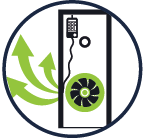
zero energy ready
Building Zero Energy Ready
Born out of the uniquely personal commitment of our founders, Brightwater was intentionally designed to be a unique homebuilding company – one where sustainability and environmental responsibility are daily priorities to build better, healthier new homes. Today, it’s a passion that the whole Brightwater team shares.

what is a zero energy ready home?
A Zero Energy Ready Home is a high-performance home that is so energy efficient that a renewable energy system, like a solar panel array, could offset most or all the home’s annual energy use. Each Zero Energy Ready Home meets rigorous efficiency and performance criteria found in the U.S. Department of Energy’s Zero Energy Ready Home National Program Requirements now known as the DOE Efficient New Homes Program, and homes are evaluated and verified by a qualified third-party as part of the certification process.
Zero Energy Ready Homes are made up of components and building systems that are carefully designed, constructed, and installed to allow the house to work together as one system, delivering superior performance, comfort, efficiency, and durability.

What are the key benefits of a
Zero Energy Ready home?
 Enhanced Savings
Enhanced Savings
Even before conversion to Net Zero Energy, a Zero Energy Ready Home is already significantly more efficient than the typical new home. That means tangible savings in the cost to own and operate your home
 Environmental Impact
Environmental Impact
By preparing to offset any draw on finite energy resources, a Zero Energy Ready Home can minimize its own impact on the environment, helping to preserve and protect it for generations to come.
 Health & Comfort
Health & Comfort
The high performance of a Zero Energy Ready Home means a cleaner, healthier environment for your life thanks to products and systems that are designed to reduce airborne pollutants and to improve the indoor environment.
 Wise Investment
Wise Investment
Because they are built to such high quality and performance standards, Zero Energy Ready Homes cost less to own and may even garner higher resale values.

what’s inside a zero energy ready home?
A great deal of design, engineering and building technology goes into meeting the rigorous performance standards it takes to create a Zero Energy Ready home. Here are just a few keys that make the difference in a Brightwater home.

Solar Energy Ready
Solar panel arrays generate energy. Brightwater’s Zero Energy Ready homes are solar ready, meaning wiring pathways, panel space and other details are included, making the addition of a solar system easier.

A Smart Envelope
As we build for Zero Energy Ready, we seek out every possible way to maximize the efficiency of performance of every material we use. Staggered stud walls create semi continuous insulation, like a blanket wrapped around the house, and greatly improve the air seal as well. This technique is combined with the use of a safe, non-toxic open cell spray foam insulation for the walls and the underside of the roof which provides superior insulating performance and avoids the gaps of traditional batting or blown-in insulation.

High Performance Heating & Cooling
Extremely high efficiency in heating and cooling is critical to achieving Zero Energy Ready. That’s why Brightwater uses single, zoned, variable speed 18 SEER electrical HVAC systems from Lennox® with 2 or 3 thermostats depending on the home. Not only are these systems highly efficient, but the variable speed minimizes starts and stops which means less electricity usage, less noise and better humidity management. Brightwater also uses Rinnai® tankless water heaters with a recirculation pump which learns your home’s routines and recirculates based on your schedule– maximizing both efficiency and comfort.

A Tight Seal
Anywhere that a home leaks air, it essentially leaks energy. So one of the keys to achieving Zero Energy Ready performance is to ensure a tightly sealed home. The tightness of a home’s seal is measured through third-party blower door testing. A calibrated fan is installed in an otherwise sealed doorway while all other exterior openings are closed. When the fan is turned on, it creates a pressure differential between the inside and outside, allowing testers to measure the amount of air leaking from the home. The standard metric for a blower door test is called ACH50 and indicates how many times the volume of air in the house changes per hour. The lower the ACH50, the less air leakage there is. While current building standards look for an ACH50 under 5, Brightwater’s target for ACH50 is 1 – meaning 5 times less air leakage than the current standard.
